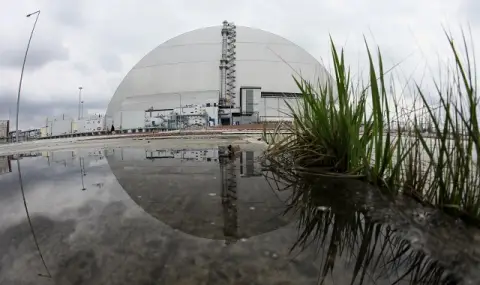In mid-February, a Russian drone pierced the protective cover over the fourth unit of the Chernobyl nuclear power plant. The repair is extremely difficult, the hole measuring 15 sq.m. has not yet been closed. Is there a risk of radiation?
For weeks, Ukrainian authorities have been looking for ways to close the gaping hole in the protective cover of the damaged fourth unit of the decommissioned Chernobyl nuclear power plant. On the night of February 14, a Russian drone pierced the protective cover, also known as the "new safe sarcophagus" (New Safe Confinement, abbreviated NSC). The attack also caused a fire that caused significant damage to the roof structure. The fire was not extinguished until March 7, three weeks after the impact.
"The priority task is to close the hole measuring about 15 square meters, but also more than 200 smaller holes in the shell," said Grigory Ishchenko. He heads the Ukrainian state agency responsible for managing the exclusion zone around the Chernobyl power plant, which is now also dealing with the damage caused by Russia.
Not all the damage has been recorded yet
The new protective cover has been erected over the old sarcophagus, which provided temporary protection. The NSC is designed to prevent the spread of radioactive radiation from the fourth unit of the nuclear power plant, which crashed in 1986. For the construction of the new protective shell, 45 donor countries joined forces with Ukraine and raised more than 1.5 billion euros. The project involved 10,000 people from 40 countries. It took almost 12 years to complete the facility, which has been operational since 2019.
According to Ishchenko, there is still no preliminary assessment of the damage caused by the Russian attack in February. Such an assessment will be made after the investigation is completed.
"Radiation levels are normal. The staff continues to work as before. Only the pressurization system is no longer working and a slightly increased humidity is measured. This is due to the impact and the drop in pressure under the hull, which is no longer pressurized," explains Ishchenko.
Could radiation leak out?
According to experts, the decrease in pressure in the protective hull does not pose an immediate threat, but there are other dangers. The breach in the new containment does not allow the safe dismantling of the old concrete sarcophagus erected over the destroyed unit of the plant immediately after the Chernobyl accident, says Dmitry Khumenyuk of the State Scientific and Technical Center for Nuclear Energy. It is for this purpose that the new steel cover over the damaged unit was built. The old concrete sarcophagus has 18 unstable beams and there are fears that one of the three main beams in the structure could collapse at any moment. If this happens, radiation could leak into the atmosphere, warns Khumenyuk. "Currently, the containment is not fulfilling its function of containing the products that are the result of the fission processes that continue underneath it," he also points out.
However, experts say that at this stage there is no need for people to stock up on iodine tablets or evacuate. However, they emphasize that all the efforts made by the international community to raise funds and build the protective cover have unfortunately gone to waste.
How can the hole be closed?
"It will be impossible to weld and repair the damaged casing on site, because the radiation levels there are very high and the workers will be exposed. The protective cover was built next to the failed nuclear unit, then slid on rails to the right place. Since the rails have already been dismantled, another solution must be sought," explains Dmitry Humeniuk.
Jan Vande Pute from "Greenpeace" - Ukraine sees only one way out – the rails to be reinstalled, the damaged protective shell to be moved to a safe distance where the expensive repair can be carried out, and then repositioned on the destroyed nuclear unit.
It is not yet clear how much this repair will cost. As a start, the International Chernobyl Cooperation Account (ICCA), managed by the European Bank for Reconstruction and Development (EBRD), will allocate €400,000 for an expert assessment of the damage.
